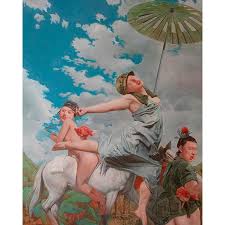Some experiences exist beyond the framework of verbalization or images, and deals basically with the nature and behavior of psychological and psychic energy.
We are are a personified energy source. We give birth to dream images of our own — hardly aware that we have done so, unconscious of the fact that we have provided impetus for a kind of psychological reality that quite escapes our notice. The dream stories we begin continue on their own. No dream is stillborn.
Our own greater reality hovers about in each instant. If we knew in precise terminology how we grew physically from a fetus to an adult, if we could consciously follow that process, we would not necessarily be better off, but possibly hindered in our growth; for we would begin to question: “Am I doing it right?” The perfection of the process would make us ill at ease.
In the same way, a step-by-step illustration of the nature of the dream state might well make us too self-conscious. We would begin to question: “Am I dreaming right?”
Many people are in awe of their dreams. They are afraid of anything they do not consciously control. Yet if we think of our dreams as extensions of our own experience in another context, then we can indeed learn to gain ease with them. We will recall them more easily, and as we do we will be able to maintain a sense of continuity between the waking and dream states.
As this happens the contours of our own psyche will appear more clearly. Those contours will not show themselves in terms of definite mathematical-like propositions, however, but will emerge through the techniques, symbols, feelings, and desires usually attributed to creativity.
The characteristics of creativity appear most clearly in children. Creativity implies abandon within a framework that is accepted for itself, and itself only.
If in our waking hours we playfully make up a dream for oneself, and then playfully interpret it without worrying about implications, but for itself only, we will unwittingly touch upon the nature of our own nightly dreaming. Our regular dreams and our “manufactured” ones will have much in common, and the process of manufacturing dreams will acquaint us with the alterations of consciousness that to a greater degree happen nightly. This is an excellent exercise. It is particularly beneficial for those who have a too-rigid mental framework.
The playfulness and creativity of dreams are vastly under-rated in most dream studies. Children often frighten themselves on purpose through games, knowing the game’s framework all the time. The bogeyman in the garden vanishes at the sound of the supper bell. The child returns to the safe universe of tea and biscuits. Dreams often serve the same purpose. Fears are encountered, but the dawn breaks. The dreamer awakes for breakfast. The fears, after all, are seen as groundless. This is not an explanation for all unpleasant dreams by any means, yet it is a reminder that not all such events are neurotic or indicative of future physical problems.
Man’s mind exuberantly plays with itself. In dreams it uses all those splendid energetic abilities freely, without the necessity for physical feedback, caution, or questioning. It seeks realities, giving birth to psychological patterns. It uses itself fully in mental activity in the same way that the kitten does in physical play.
When we try to explore the psyche in deadly seriousness, it will always escape us. Our dreams can be interpreted as dramas, perhaps, but never as diagrams.
Do not try to bring “dream interpretation” down to our level, but instead try to playfully enter that reality imaginatively, and allow our own waking consciousness to rise into a freer kind of interpretation of events, in which energy is not bounded by space, time, or limitations.






